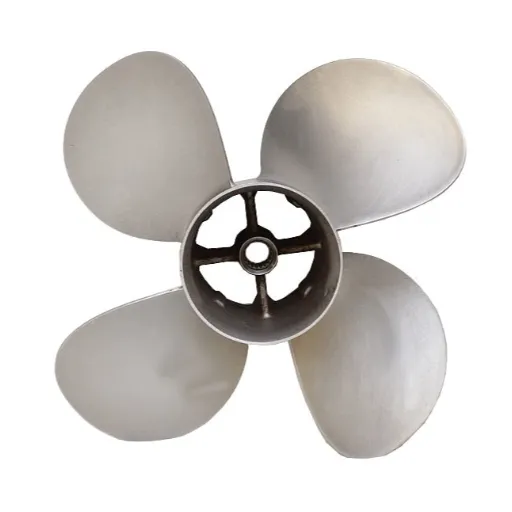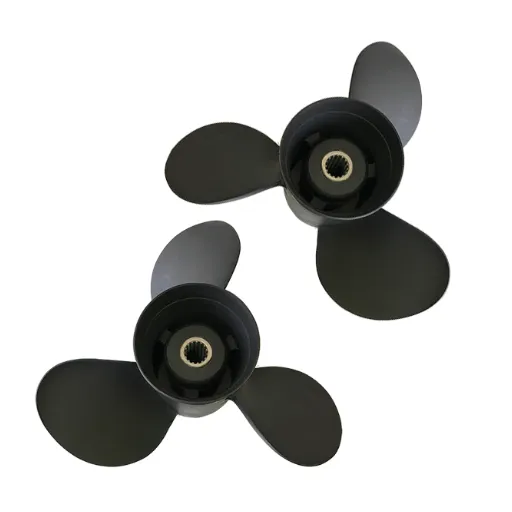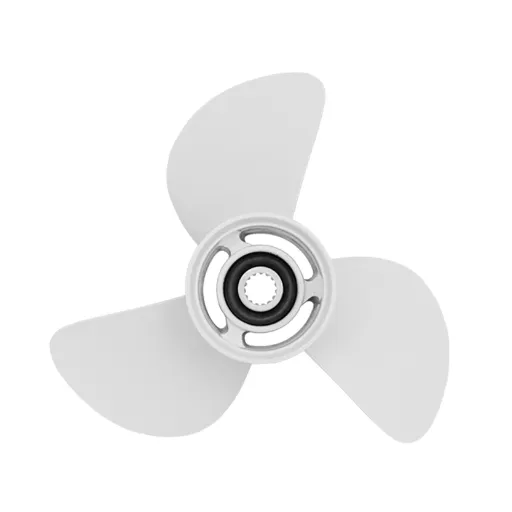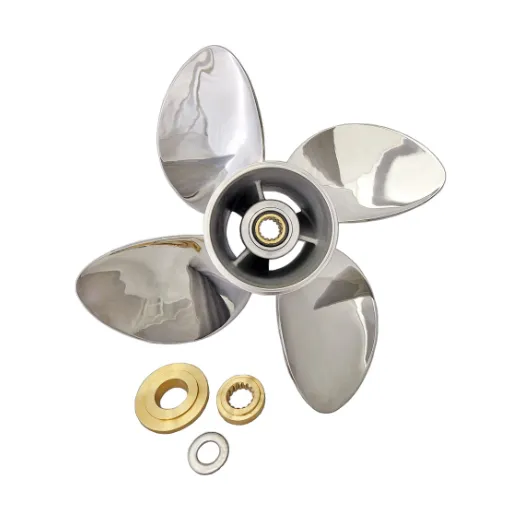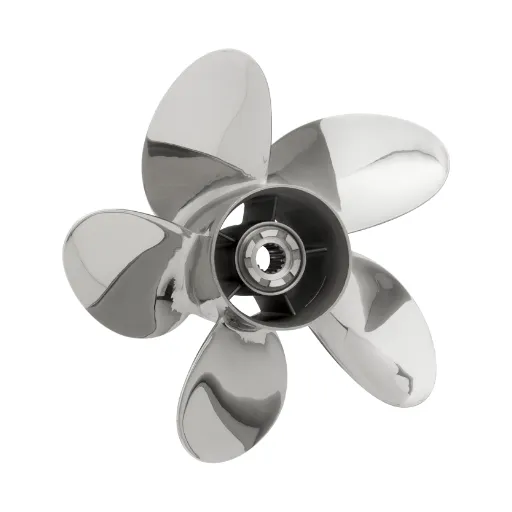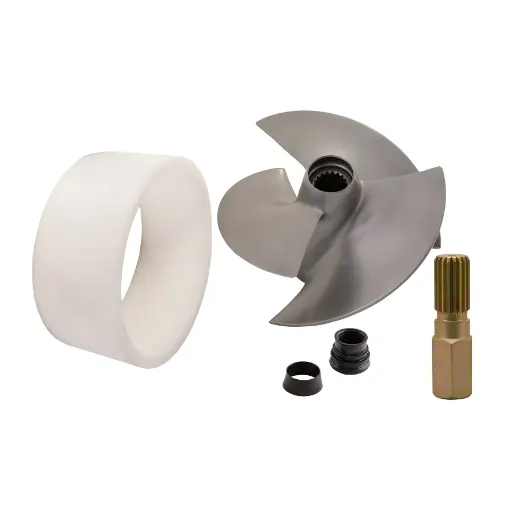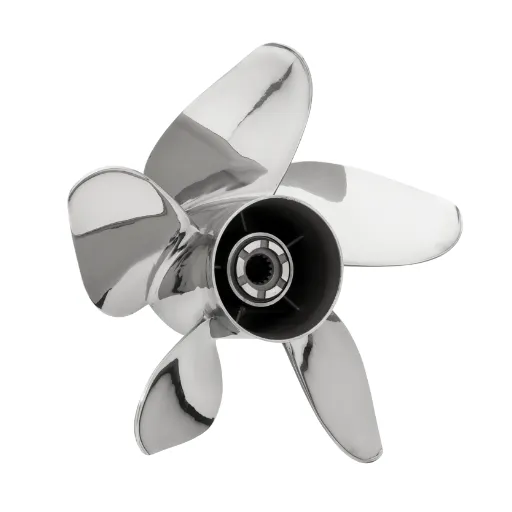Since choosing your boat’s right propeller is like navigating uncharted waters, a boat has so many variables to consider-diameter, pitch, material, and overall performance-that giving it the wrong choice could be detrimental. The more efficient chosen is the correct prop, and that includes the efficiency of the boat, fuel economy, and overall handling. This guide is designed to demystify the basics of propeller selection, breaking down everything in simple terms, so you can make an informed decision and have smoother and more reliable adventures on the water. When upgrading your prop or getting a damaged one replaced, this article will lead you on the perfect track.
Understanding Propeller Specifications
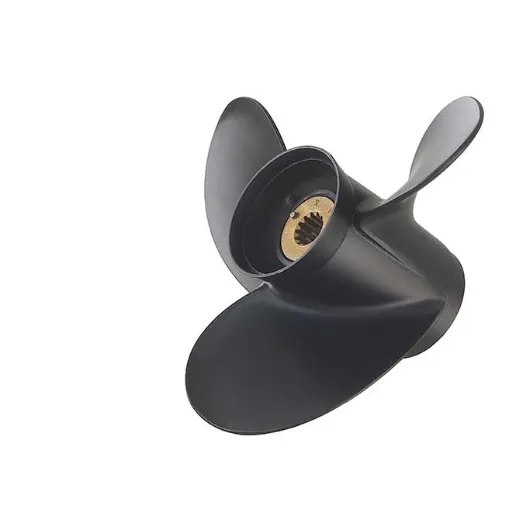
Diameter and Pitch: What You Need to Know
The diameter of an impeller is the distance across the circle formed by the rotation of the blades. It is important in determining the volume of water displacement by a propeller. Typically, impellers displacing more water are used by larger and slower boats. On the other hand, impellers with smaller diameters would be suitable for a lighter, faster boat because it reduces drag and allows for greater RPM.
The pitch, in simple terms, is the distance that the propeller travels forward in one complete rotation, assuming no slippage. A high-pitch propeller is built for greater speed due to the distance it travels per rotation while it takes more power to turn. A low-pitch propeller accelerates faster and is ideal for towing activities such as water sports or heavy loads because it generates higher thrust at lower speeds.
A propeller of a suitable diameter and pitch is chosen, depending upon an engine’s specifications, the activities involved, and the desired performance. For the greatest efficiency, the manufacturer’s instructions shall always be followed with some testing of some options that can be tried out in actual duties to see which performs best in speed, power, and fuel economy.
Blade Count: How It Affects Performance
Generally speaking, the fewer the blades on a prop, the better the speed and efficiency, as less drag is created from the spinning. These two or three-blade props are used on smaller boats or boats that want faster speeds under light conditions.
However, propellers with four or more blades provide a better thrust and smooth finish at low speed under heavier load. This type of propeller is better suited to independent boats that require more power in towing, rough water, or bigger vessels. While multi-blade props may compromise some top-end speed when compared to those with fewer blades, they accelerate much better and provide more stability.
The number of blades that go on a propeller is an important thing to consider for your boat, as it’s all about suitability and use. Fewer blades will yield more speed. However, more blades may be favorable when heavy work or a stable ride is required. Basically, check the directions, manufacturer, and try out each installation over actual conditions to see what works best for your boating needs.
Material Options: Aluminum vs. Stainless Steel
Among the common materials for propellers, aluminum and stainless steel can fit the design requirements, each having its peculiar advantages according to the boat-owner’s needs and budget. Aluminum is lighter and less expensive to manufacture; in fact, it is cheaper on the whole and preferred for recreational purposes or smaller crafts where price and ease of maintenance take precedent. It is also a bit softer compared to stainless steel; hence, if one hits an obstacle, it will do least damage to the engine or drive system.
In contrast, the stainless steel propellers are far stronger and more durable than the aluminum ones. This extra strength allows them to have thinner blades shaped most accurately to give better performance and efficiency. Also, stainless steel offers better corrosion and wear resistance, making it an excellent choice in a saltwater setting or heavy-duty application where performance and reliability are of prime importance. These advantages come with a steeper price and, sometimes, repairs and maintenance are more expensive.
So make your choice taking into account your budget, the type of water through which you would navigate, and what you expect in performance. Aluminum is usually all right for casual boaters and freshwater purposes, and it is less expensive. But for demands of very high performance or in a saltwater environment, the added cost for stainless steel is worth every penny due to its ruggedness and efficiency.
Choosing the Best Prop for Your Boat Type
Factors to Consider Based on Boat Type
The best propeller for your boat depends heavily on the kind of boat you have. For smaller boats like fishing boats or pontoons, the right propeller should offer the required thrust at lower speeds for proper handling and smooth operation. Aluminum propellers are usually installed on such boats because they are cost-effective and meant for leisurely cruising or freshwater navigation. In contrast, bigger boats such as cruisers or sport yachts would want stainless steel propellers capable of providing better durability and performance over long distances or demanding conditions.
The special activities for which your boat is utilized should also weigh in on the decision. Water sports will require fast propellers with aggressive pitch and rake so as to accelerate speed quickly and hold it constant: wakeboarding and skiing. A boat for a slow cruise or a long excursion could, thus, use propellers that are designed to give fuel efficiency and smooth operations, ensuring that the boat runs at steady speeds and can handle itself over long periods. Making sure the type and material of a propeller are best suited to your regular application means optimum performance and a more enjoyable marine experience.
The other factors to be considered are the engine size, the hull design, and the weight distribution, as these affect how a propeller will carry out its duties on your boat. When all these are well balanced, the power flows efficiently from the engine to the water for maximum speed and control. Application of these insights to your precise needs, coupled with local advice from a qualified marine technician, will allow you to make the best decision in regard to performance and longevity.
Intended Use: Fishing, Water Sports, or Cruising
In this domain, choosing an optimal propeller should be based on the particular intended use and the performance demands for that activity. In fishing, the main considerations become maneuverability at low speeds and fuel efficiency. Anglers tend to favor a propeller with a lower pitch to achieve control and power at slow speeds through the shallow waters, or to maintain slow speed precision while they cast. The second characteristic that is very important in environments where debris is common is durability; thus, stainless steel or treated aluminum propellers are considered for choice.
For water sports, such as skiing or wakeboarding, it would have to be an acceleration issue rather than a top-end speed. The high-pitch, low-blade prop offers whatever pull may be required to lift the rider with speed, so the actual thrill comes in holding the speed. A good number of the water sportsmen go for four-blade propellers, which provide a pleasing compromise between top speed, thrust, and lesser cavitation. For towing jobs, an adequately fitted setup would give excellent performance while maintaining good safety.
Cruising boats demand an altogether different set of features, with emphasis on fuel economy and a smooth ride over long distances. Medium pitch and blade numbers are typical for casual cruising, giving steady performance without putting too much strain on the engine. For very long distances with cruising at moderate speed, some propellers are engineered to minimize fuel consumption and hence it reduces the high running cost of utilizing it. Propellers that are matched to cruising patterns let you enjoy your boat with maximum comfort.
Defining the primary boat application—whether it be fishing, water sports, or cruising—alongside matching it to the appropriate propeller can guarantee fine-tuning of performance while never compromising the engine’s efficiency and reliability.
Performance Considerations
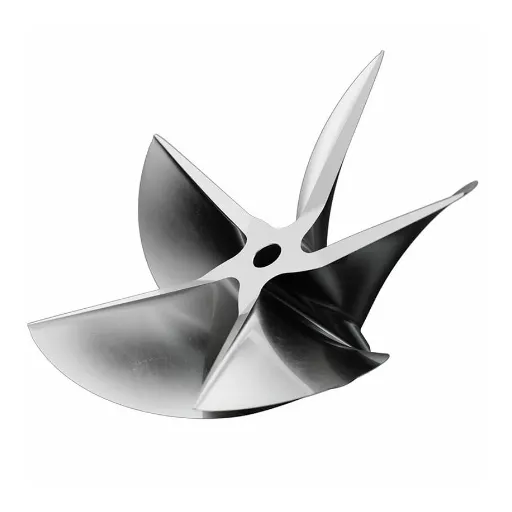
Impact of Propeller on Fuel Efficiency
As regards the fine-tuning of fuel efficiency that the boat affords, the propeller is a major player. Selecting a propeller causes considerable fuel saving and improved performance. Listed below are five major factors that determine a propeller’s influence on the fuel efficiency of a boat:
- Propeller Pitch: The proper pitch in a propeller allows the engine to operate in a safe RPM range. Pitch too high or too low would have the effect of overloading the engine, consequently higher fuel consumption.
- Diameter of the Propeller: A larger diameter can produce more thrust at lower speeds, which is beneficial for cruising fuel efficiency. But under high speed, a propeller with slightly smaller diameter may be more fuel-efficient.
- Number of Blades: Generally, the fewer the blades, the lower the drag that results, thus enhancing fuel efficiency at higher speeds. Alternatively, it may be the case that a higher number of blades leads to smoother performance that is better in the case of heavy loads or slow speeds.
- Material of the Propeller: Lighter, cheaper aluminum propellers flex under heavy loads, slightly lowering efficiency. The more expensive stainless steel propellers retain their shape and performance, promising better fuel savings.
- Regular Maintenance: Regular maintenance, e.g., cleaning and repairing damaged blades, keeps the propeller running well. Even slight nicks and bends will reduce fuel efficiency by creating drag and disturbing the flow of water.
When these issues have been well considered, boat owners will be able to perfect their prop configuration for a better fuel economy and better performance once in the water
How Pitch and Diameter Affect Speed and Handling
The pitch and diameter of the propeller teller remain vital factors in the determination of speed, efficiency, and handling of the boat. The pitch of any propeller defines the theoretical forward distance that the propeller would move in one full rotation, while the diameter is the length of the circle traced out by the spinning blades.
Greater pitch usually means greater speeds, since the boat covers greater distance per rotation; this, however, requires more engine power and reduces acceleration. Lesser pitch, on the other hand, affords better acceleration and tow thrust or propelling capacity for heavy loads, limiting the top speed, however. If we think about diameter, it really is the volume of water that our propeller can displace, which in turn translates into thrust. Bigger ones are more often used on big and slow ships, while smaller ones are meant for the lightweight and fast boats.
Adjusting pitch and diameter in an almost equal way allows a boat owner to mold its performance according to its own requirements, that would be getting the highest speed in the open waters, or the specific handling needed for very tight maneuvering.
Four Blade vs. Three Blade: Which is Right for You?
This propeller is three-bladed and therefore offers high speed and more efficiency. In contrast, a four-blade propeller excels at giving performance at low speeds with additional stability and economy for a heavy boat.
| Key Point | Three-Blade | Four-Blade |
|---|---|---|
| Speed | Higher | Lower |
| Efficiency | Better | Slightly less |
| Stability | Moderate | Higher |
| Low-Speed | Less effective | Better performance |
| Economy | Moderate | Better for heavy use |
| Drag | Lower | Higher |
| Cost | Lower maintenance | Higher maintenance |
Common Mistakes to Avoid
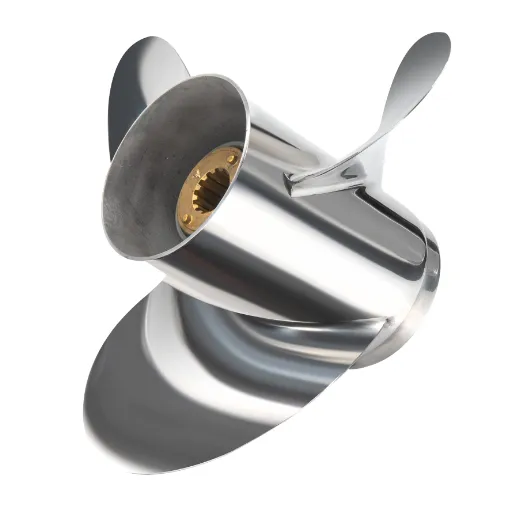
Choosing the Wrong Size Propeller
The wrong propeller size is probably the most common mistake an owner can make that can render performance and efficiency of any boat. A propeller too large or too small may however result in inefficient power delivery, increased fuel consumption, and even undue stress on the engine. There needs to be utmost precision in ordering a propeller with the right diameter and pitch for your boat’s engine and its intended application. I personally think that consulting the boat manufacturer or a marine professional will always lead you in the right direction.
From my experience, incorrect specifications take their toll on the handling and speed of the boat too. For example, a high-pitch prop will be slow off the mark and put a real load on the engine; a low-pitch prop will put the engine over the top and wear it out prematurely. Taking the above into consideration will ensure that the boat performs to expectations, be it for cruising, fishing, and/or skiing.
Regular maintenance is just as important as the proper sizing of a prop. An unbalanced or damaged prop can behave just like an improperly sized one, producing the same adverse effects of inefficiency and poor performance. Through proper maintenance and correct matching of the propeller with the boat and engine, I have been able to get the most out of performance while also preserving vital components for longer. It is always worth going the extra mile making the right, informed decision on your propeller.
Overlooking Material Quality
Usually, overlooked while choosing a propeller are the material quality considerations. Propellers usually come in aluminum, stainless steel, or composites, each bearing a set of advantages and disadvantages. Aluminum propellers, unlike other propellers, are light, cheap, and most common, making them a favorite among many boat owners. Aluminum propellers, however, can be dented and damaged when hitting underwater debris or rocks more easily. Antiquated stainless steel propellers are cast from higher melting points, giving them excellent application performance. At the same time, they require a much higher investment, inhibiting the investment decision of an average purchaser.
Quality of the materials does not only include durability but also performance. Popular materials like stainless steel, to a certain extent, retain their form against loads better than, say, aluminum propellers, which do flex at higher speeds. This translates to greater efficiency and higher speed performance in the majority of instances. Less common are the composite materials, which strike a mid-way between cost and strength and might be considered useful in certain cases. So in the end, you must understand these trade-offs in materials so you can pick a propeller suitable to the mechanic demands of your boating activities.
In addition, the consideration of material can also influence maintenance and long-term costs. Aluminum propellers are cheaper to repair but may demand frequent maintenance due to their propensity for wear and tear. Stainless steel types tend to require almost no maintenance but may turn out to be more expensive to repair if a major damage occurs to them. Investigating the quality of the material on a basis of your boating environment, performance objectives, and budget will keep you far from the hurdle of thin research, ensuring a more efficient and cost-effective choice in the long run.
Ignoring Boat and Engine Compatibility
Among the many considerations ignored when buying a propeller is the compatibility of the propeller with the specific boat and engine. Lowered efficiency, lack of performance, and engine damage could be a potential occurrence when mismatching the three components. For example, fitting a propeller of an incorrect pitch or diameter to your boat engine will result in an excessive load, overheating, or fuel inefficiency. Therefore, it is vital to understand manufacturers’ recommendations to ensure all components work harmoniously. Skipping this essential step could result in poor performances with costly repairs.
Another common problem arises while selecting a propeller based on availability or price without weighing in on if such propeller would complement a design and usage of the boat. For example, a propeller working fine at speeds would not do a fishing vessel any good, which requires slow speeds with a lot of thrust. Likewise, a propeller that does well in calm freshwater lakes would not in the rough saltwater setup. The utmost importance is researching exactly what kind of specs the propeller should have for purpose application to get optimal performance and longer life.
After obtaining accurate measurements for your boat’s weight, engine power, and intended use, you should avoid mismatches that might be caused by incompatible propeller choices, thereby assuring a safe and fair boating experience. It is always worth putting in the effort to research for compatibility to avoid disappointing results and a big dent in your pocket.
Maintenance and Replacement Tips
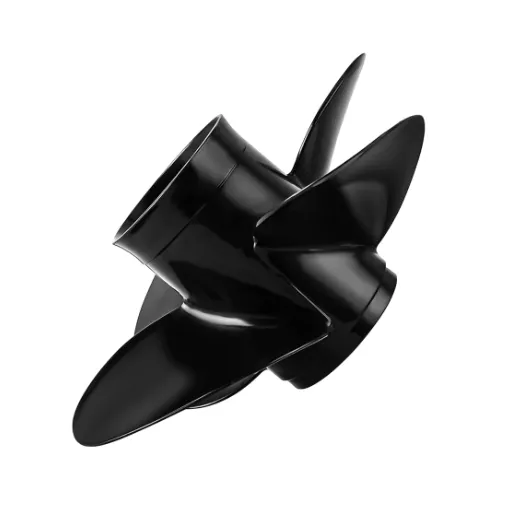
How to Maintain Your Boat Propeller for Longevity
Proper maintenance of the propeller of your boat is crucial for better performance and a longer lifespan. Getting into the habit of regularly checking the propeller for any damages, such as dents, cracks in its casting, or bent blades, will be a good one. Even the minutest imperfections disturb balance and wear down efficiency. Cleaning the propeller one time after using it is equally necessary; debris in the water, fouling, and fishing lines can gather and cause wear that worsens over time.
The corrosion-resistant coating should also be applied, especially on vessels operating in saltwater, to discourage rust and general degradation. Keep an eye out for corrosion first of all around the hub and blade edges and clean it out whenever you see buildup. You should regularly inspect and replace the shear pin or key of the propeller to make sure it is seated securely and works correctly.
Proper maintenance can be achieved by preventing seizing of the propeller shaft with grease and ensuring easy removal during maintenance, as well as, application of the right marine grease while removing or installing. Lastly, a spare propeller and the tools to fix it should always be onboard to remedy any sudden problem that may crop up while fishing in the waters. Proactive maintenance will save fuel consumption, retain optimum performance, and minimize repair costs in the long run.
Signs It’s Time to Replace Your Prop
The boat propeller is crucial for premium performance, and one must know when to replace it. The main signs to watch out for are physical damages. Chips or cracks, or bent blades, tremendously reduce the efficiency, whereas vibrations caused by them can also lead to damaging the engine and driveline further. If you notice any visible defects during your routine inspection, that means the propeller is most likely due for replacement rather than mere repairing.
The other important sign is the differing performance. In cases where your boat is not able to reach the usual top-level speed or is slow to accelerate or able to keep cruising speed only for a while, it is most likely that the propeller is worn or not sufficiently sized for the boat. Also, look out for increased cavitation or slipping, which means your propeller isn’t “gripping” the water well. Sometimes, these issues arise from serious wear or incorrect pitch; other times, they can come from almost unnoticeable deformities in the blades of your prop.
Finally, you should notice if your boat’s fuel efficiency changes. A damaged or inefficient propeller can dictate an engine to work harder and thereby consume more fuel than the usual. In case you have found a sudden or gradual increase in fuel consumption, chances are that an inefficient prop could be the cause of this. Keeping a propeller in fine working condition ensures high performance, saving fuel and preventing long run damage to important engine components. Especially with inspections at regular intervals and replacements wherever proper, your boat remains smooth and safe to go on.
Tips for Installing a New Propeller
- Choosing the Right Propeller: Installing the right propeller is essential to achieving the best performance. The size, pitch, and material must correspond to your boat and the usual water conditions. Double-check that the prop is compatible with your engine model and that it is an appropriate prop for cruising, fishing, or water sports.
- Prepare the Necessary Tools: Before beginning any installation work, make sure you gather all the necessary tools, including a socket wrench, prop nut, and grease. Having all your tools handy speeds up the process and prevents unnecessary delays.
- Check for Any Damage or Wear: Inspect the new propeller and the propeller shaft for signs of damage, rust, or debris. Make sure the keys and keyways are clean and in good condition, as even slight imperfections may affect performance.
- Grease the Propeller Shaft: Lubricate the propeller shaft with marine grease to prevent corrosion and make installation easier. Proper lubrication also gives you easier removal later; the prop can be pulled off without much force.
- Install with Proper Alignment: Slide the new propeller onto the shaft carefully, making sure it is perfectly aligned. Washers can be placed in, and the prop nut tightened securely, but never over-tighten it as it would induce unwanted stress or damage to the threads.
- Use the Right Cotter Pin: After securing the prop nut, put through a cotter pin for locking it in place. Ensure the size and material are perfect for durability and security during operation.
- Prepare to Test: After installation, put the prop into operation in a rated environment to check that it runs smoothly. Listen out for any unusual noises or vibrations that may indicate improper installation.
This way, if the prop has gotten a little bigger or more potent in the past few years, a proper setting will be considered while mounting the prop and shaft in the field, resulting in better boat performance and longevity. After that, periodic maintenance checks can be conducted to preserve the optimal boating conditions.
References
- Design of a propeller for a human-powered boat– This paper from MIT discusses the design and testing of propellers for boats, providing insights into performance optimization.
- Planning for Public Boating Access: A Geographic Information Systems Approach – This NOAA publication evaluates site suitability for boating infrastructure, which can indirectly inform propeller selection based on boating conditions.
- Federal Regulations– This document outlines considerations for boating projects, including environmental and regulatory factors that may influence propeller choice.
Frequently Asked Questions (FAQ)
Q: What are some factors that I should weigh in learning how to choose the right prop for your boat?
A: When choosing the right propeller for your boat, you need to consider your boat’s horsepower, the engine’s type, and the purpose for which the boat is used. These will influence the pitch, diameter, and material of the propeller (aluminum or stainless steel) and will translate directly into boat performance. Another factor to consider is boat performance at WOT, alongside engine RPMs. These will certainly help the buyer make final decisions on prop selection.
Q: How does propeller pitch affect the performance of your boat?
A: Pitch determines the distance traveled by a boat in one revolution of the propeller. Higher pitch propellers give better top-end speed but lower acceleration, whereas a lower pitch propeller aids in holeshot and acceleration but will limit top speed. Yielding the right pitch for your boat prop is key from performance to fuel consumption perspective.
Q: What importance does diameter have when choosing a prop for your boat?
A: The diameter of a propeller determines thrust by application on the water and also other aspects that affect the overall performance of your boat. A large diameter could work well for a boat for better low-speed operations or efficiency. Smaller diameter props have the ability to spin freely and thus work for top-end horsepower. Diameter is, along with pitch, one of the essential parameters for building your guide for the correct prop for your boat.
Q: How can I tell if I have the wrong prop?
A: Signs that show you might be in possession of the wrong prop shall include hitting your rev limiter, lousy acceleration, and a lack of control at different speeds. If your boat has difficulty getting on plane or has trouble maintaining a steady RPM range, then checking up on your propeller might be a good idea.
Q: What differentiates aluminum and stainless steel props?
A: Aluminum props tend generally to be of the less expensive variety and for layman-style recreational boating; in contrast, stainless steel props would give durability, high-speed better performance, and from an efficiency standpoint, better fuel consumption. Therefore, the type of prop used depends on the user’s habits and budget.
Q: How does horsepower affect my choice of propeller?
A: Horsepower of the outboard motor directly affects the choice of propeller. A high horsepower engine would be able to have a large diameter and a high pitch prop installed. Whereas a low horsepower engine may require a small diameter and low pitch prop to maximize performance so that the engine would not hit the rev limiter.
Q: How best can I check for the right prop for my boat?
A: The best way to determine the correct prop for a boat is by considering various aspects of the boat itself, such as weight and intended use, and testing different props. One would take performance readings at wide open throttle (WOT) and ensure that engine RPMs fall within the optimum range set for that very motor.
Q: What does a four-blade prop do in terms of performance?
A: A more four-blade prop can give you more low-speed power and better control over a three-blade. This kind of prop is useful in getting your boat on plane quickly and keeping it under control, so it is really good for the all-around kind of performance.
Q: Would I be able to repower my boat with the same prop?
A: The design of the propeller on the boat may have to be rethought when performing a repower. The new engines may tend to have different horsepower and torque characteristics, and hence, the new one may require a different pitch or diameter to achieve maximum efficiency.




